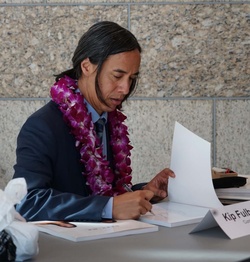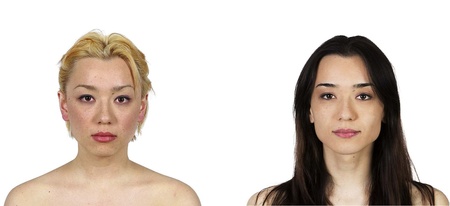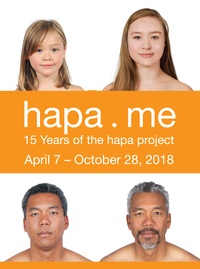Artist/writer/performer Kip Fulbeck launched The Hapa Project in 2001, photographing more than 1,200 people of mixed Asian or Pacific Islander heritage. His intent was to raise awareness and understanding of multiracial people and to help them (especially children) form positive self-identities. The work led to a landmark book and related exhibition in 2006: kip fulbeck: part asian, 100% hapa.
In the years since, he has spawned multiple books and exhibitions, spoken throughout the U.S. and abroad, and had his work shown in more than 20 countries. In his latest exhibition, hapa.me, on view at the Japanese American National Museum (JANM) in Los Angeles, he revisits many of the same people he photographed more than 15 years ago and reflects on how they have changed, physically and emotionally. The occasion also provides Fulbeck an opportunity to reflect back on his own journey as an artist and multiracial person.
Discover Nikkei had the pleasure of catching up with Fulbeck—who graciously agreed to be interviewed while recuperating from an unexpected illness.
* * * * *
DN: Can you comment a bit on the inspiration for this new/updated iteration of the show? What inspired you to want to revisit these people, and why now?

KF: I had wanted to do a follow up book for years, but my publishing contract wouldn’t allow it. Now that the first Hapa book has finally gone out of print, the rights reverted back to me and I immediately began producing hapa.me. The new book is much larger – 11”x11” – and along with hundreds of images also features essays by major Hapa luminaries. I’m really proud of it.
DN: What were some of the surprises you encountered as you reconnected with people after so many years?
KF: What was really interesting is most people seem to be in better places now. Obviously not all (and some have passed), but overall, participants just seemed a bit more settled in if that makes any sense. I remember talking to Teresa (the woman who wrote the only phrase she could say in Tagalog was “I have beautiful hair”) — she literally looks 10 years younger in her later picture ... healthier, more vibrant, more accessible. I asked her about it and she replied, “Yeah, 20s were hard!” Many people really mellowed while others found their political voices. And what was really rewarding to me — almost every person I found was excited to participate again.

DN: Back in 2005-2006 (the time of the first exhibition), it seemed like general public awareness of multiracial/multiethnic identity/issues was very low. Have you seen much change since then?
KF: It’s certainly higher now. Think of all that’s transpired since that time. We elected and re-elected a biracial President (god, just thinking about that type of optimism seems so far, far away these days – but that's a different story). More and more people speak publicly about their heritage and identity now. And the Whitewashing of APIs no longer gets ignored — in fact, it gets called out right away now (think Ghost in the Shell, Aloha, Dr. Strange, etc.). That wasn’t the case even a few years ago. APIs, who historically have not had a seat at the table of mainstream American pop culture, are utilizing new media in profoundly impactful ways.
DN: Have you noticed any generational trends/differences in how Hapa view themselves, and/or how they are viewed?
KF: It’s very difficult to quantify any generalities when you have such a varied and enormous population — when you’re talking about literally millions of Hapas. Sure, I still witness the same Hapa 101 discussions played out by newbies and people from non-diverse areas ... the “I-never-really-thought-about’s, the “I-thought-I-was-just ___’s”, the “You know, I'm-just-not-attracted-to's,”. But that’s the same for anyone coming of age, discovering their identity, struggling with the same issues, and then realizing millions before have done so in similar, perhaps even parallel ways – realizing that there are now and have been so many talented writers, actors, performers, poets, musicians, journalists, critics, and just plain everyday people navigating the very issues you are just beginning to understand yourself and they’ve been doing it for decades.
On one hand, that can be tremendously reassuring in that that you are not alone, that your negotiation of media stereotypes, dating patterns, sexual attractions, and institutionalized racism is also being navigated by millions of others. It can also be threatening. Especially if you’ve always relied on being the special one. It’s like the first visit to Hawai’i for mainland Hapas. The euphoria of finally-everyone-looks-like-me quickly gets mixed with the realization of how much you may have been relying on always standing out in a crowd, how much you’re used to getting attention, perhaps even special treatment, and how that game no longer works here.
DN: Aside from exploring ethnic identity, do you find that there are any other recurring themes/topics that often run through your work?
KF: That’s a funny question, because it assumes that exploring ethnic identity is the major focus of my artwork, and I don’t believe it is. Identity as a theme, yes ... but not always ethnic identity. Perseverance was the biggest show I ever did and it explored Japanese tattoo artistry. Sometimes I draw bittersweet animals and show them in small art galleries. I do spoken word, make sculptures, cultivate bonsai, aquascape my aquariums, play music ... these are all part of my work. Certainly, the work is always autobiographical to some extent (all art is), and I do believe that discovering, honing, and defining who we are is something I continually come back to in my creative output. But when I look at my artmaking career over time, the main themes that continually run through the work are love, loss, and life. Hence the hanging scrims in hapa.me.
DN: How do you feel your art has evolved in recent years? Are there themes or techniques that you find more compelling now than in the past?
KF: That’s easy – I got okay with doing Hapa work again. That may sound strange, but It’s something I consciously fought against for many, many years. The Hapa Project artistically defined me to so many people, got linked to me in so many ways, that whenever I’d start working on something new I’d inevitably hear, “Oh, is it about being Hapa?”
And I’d answer that all of my work is about being Hapa. I can’t not do work about being Hapa. I could be doing work about soil on Mars and it would be Hapa work. And it would also be about me being a man. And about being straight. And sometimes joyful. And sometimes lonely. And teaching and swimming and surfing. And pursuing and cherishing and longing and edging and tropical fish and shoulder surgeries and too many guitars and not enough finger dexterity. And dogs, it would be about dogs. And god, it would be about being a father and realizing none of this even matters in comparison. And hearing my son laugh and watching my daughter walk off from me without fear. The work is all about these, always.
The night after the JANM Gala (in April 2018), I ended up in emergency surgery with a life-threatening staph infection. Three weeks of three-times-daily IV antibiotics later, my blood finally cleared. You ask what themes are compelling to me? Staying alive for my kids. And not taking work arguments too seriously. And not dealing with people who suck. And surrounding myself with people who push, and work, and endeavor, and love and relax and laugh. And enjoying what my body can do, and what my mind can create. These compel me.
Two weeks ago, I was doing an interview at JANM with a Chinese journalist. The reporter and I walked into the main gallery for a photo. It wasn’t particularly crowded that day, but a museum visitor recognized me and came up to talk. He was probably about 30 years old. He wanted to introduce himself and tell me how much my work had meant to him, but a few sentences into it he began tearing up and unable to talk. So I reached out and held him a bit, and told him thanks. That’s the best gift he could ever give me an artist.
So to your question about themes ... I’m okay with The Hapa Project being the majority of my artistic legacy. Actually, I’m more than okay with it now. I’m proud of it. There was a time when I wanted to say, sure but I also do x, y, and z. There was a time when I wanted to tell people that, to show them right then and there, to prove that me as an artist was more than this artwork. Maybe this comes from being programmed to be a doctor and being repeatedly told art isn’t a job and all artists starve throughout my formative years. Maybe it’s just me being insecure as an artist, that no matter how big a work I produce, it’s never quite enough – it’s always chasing the dragon. But interestingly, and refreshingly, I don’t have that urge to explain what else I do anymore. My new challenges are mine and that’s kind of nice. Maybe I’ll share them and maybe people will respond to them. I hope so.
* * * * *
hapa.me – 15 years of the hapa project
April 7 - October 28, 2018
Japanese American National Museum
Los Angeles, California
Artist Kip Fulbeck continues his project, begun in 2001, of photographing persons who identify as “hapa”—of mixed Asian/Pacific Islander descent—as a means of promoting awareness and positive acceptance of multiracial identity. As a follow-up to kip fulbeck: part asian, 100% hapa, his groundbreaking 2006 exhibition, hapa.me pairs the photographs and statements from that exhibition with contemporary portraits of the same individuals and newly written statements, showing not only their physical changes in the ensuing years, but also changes in their perspectives and outlooks on the world.
© 2018 Darryl Mori








